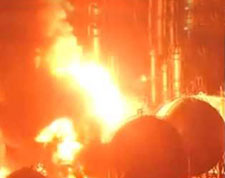Everyone has an excuse. For Cops it is they, “gotta be ready to roll”. For small town folks who leave their cars running at the curb, “it’ll just take a minute”. For bus drivers it is the mistaken notion that, “turning it off and on is harder on it then idling”. But it is all fuelish and wasteful.
http://www.afdc.energy.gov/afdc/vehicles/idle_reduction.html
Idle Reduction
Idling vehicles use billions of gallons of fuel each year and emit large quantities of air pollution and greenhouse gases. Idle reduction technologies and practices are an important way to cut petroleum consumption and emissions.
Idle Reduction Basics

Idling Facts
- Medium-duty trucks use about 2.5 billion gallons of fuel to idle each year, or 6.7% of the total fuel they consume.
- More than 650,000 long-haul heavy-duty trucks idle overnight for required rest stops at least some fraction of the time, using more than 685 million gallons of fuel per year.
Idle reduction describes technologies and practices that reduce the amount of time drivers idle their engines. Reducing idling time has many benefits, including reductions in fuel costs, emissions, and noise.
Drivers idle for a variety of reasons, such as keeping vehicles warm, operating radios, or powering equipment. Each year, U.S. passenger cars, light trucks, medium-duty trucks, and heavy-duty vehicles consume more than 6 billion gallons of diesel fuel and gasoline—without even moving. Roughly half of that fuel is wasted by passenger vehicles.
Idling can be reduced without compromising driver comfort or vehicle equipment operations. Learn about:
- Heavy-duty truck idle reduction technologies
- Medium-duty truck idle reduction strategies
- Light-duty vehicle idle reduction strategies
- School bus idle reduction strategies
:}
More tomorrow.
:}







 Futaba Kosei Hospital patients who might have been exposed to radiation are carried on stretchers Sunday morning after being evacuated from the hospital in the town of Futaba near the stricken Fukushima Daiichi nuclear power station. (AP / The Yomiuri Shimbun, Daisuke Tomita)
Futaba Kosei Hospital patients who might have been exposed to radiation are carried on stretchers Sunday morning after being evacuated from the hospital in the town of Futaba near the stricken Fukushima Daiichi nuclear power station. (AP / The Yomiuri Shimbun, Daisuke Tomita)